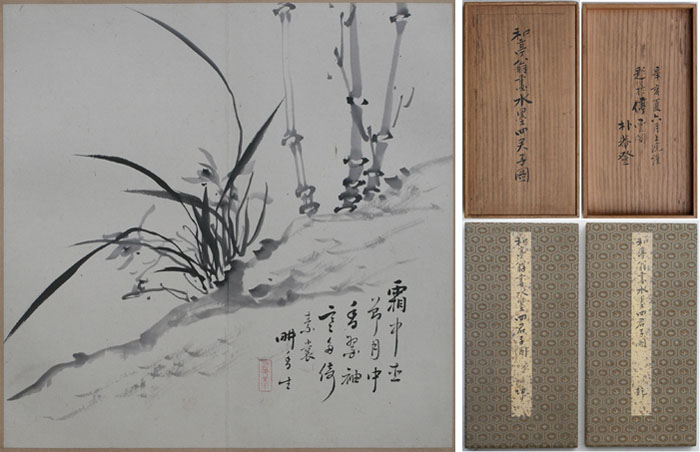Nanga
A set of 2 volumes, Shikunshi zu - The four princely plants (plum, orchid, bamboo & chrysanthemum)Signed: Katei kenkaku, Kôkô sei, Katei, Kôkô kan shujin, Katei shujin, Ran, Kôkô, Randen sei, Kôkô sei utushi
Seals: Gaheki, Shinken ka noin, Shûho, Randen, Mata na tei, Kôkô, Ken Shichoku Shinmei Ken azana wa Shichoku, Katei, Katei shujin
Technique: 33,5 x 33,3
Box: authorised in the summer 1911 by Katei’s pupil Ritsuhana Unkaku (born 1845)
Vol.2 - Kan (Heaven)
1. Orchid & bamboo
2. Chrysanthemums
3. Plum
4. Bamboo
5. Orchids & Bamboo
6. Bamboo
7. Chrysanthemum
8. Orchids
9. Bamboo
10. Orchids
11. Orchids
12. Plum
Taki Katei was one of the most popular nanga artists of the Meiji period.
He was the son of a samurai who lived in Edo (present day Tokyo). He studied under Araki Kankai (1789-1860). In Osaka he studied Nagasaki-style painting with Ôoka Umpô (1765-1848). At the age of 21.he went to Nagasaki where he studied Chinese painting with Hidaka Tetsuô (1791-1871) and with a number of Chinese painters. He initially went back to Edo, but decided to move on to northern Japan, where he stayed for ten years, keeping away from the power struggle that resulted in the Meiji Restoration.
His paintings were shown at the Vienna Exposition of 1873. In 1893 he became a member of the Art Committee of the Imperial Household.
Buckland (2013); Roberts
Price: SOLD

